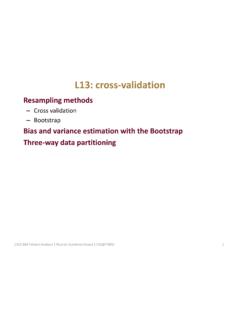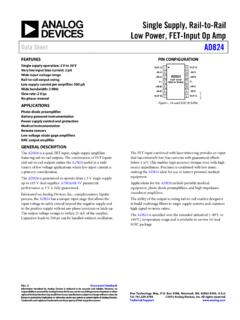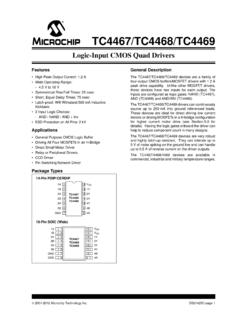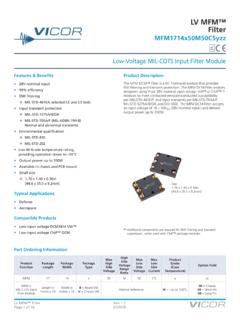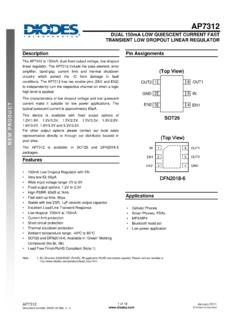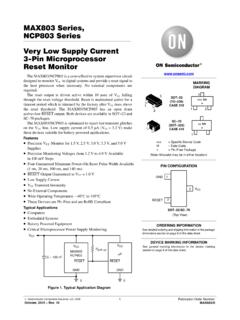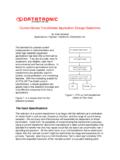Transcription of Lecture 5: The ideal operational amplifier
1 Intelligent Sensor SystemsRicardo Gutierrez-OsunaWright State University1 Lecture 5: The ideal operational amplifiergThe ideal operational amplifiernTerminalsnBasic ideal op-amp propertiesgOp-amp familiesgOperational amplifier circuitsnComparator and buffernInverting and non-inverting amplifiernSumming and differential amplifiernIntegrating and differentiating amplifiernCurrent-voltage conversionIntelligent Sensor SystemsRicardo Gutierrez-OsunaWright State University2 The ideal op-amp gPrimary op-amp terminalsnInverting inputnNon-inverting inputnOutputnPower supplyFrom [Car91]
2 Intelligent Sensor SystemsRicardo Gutierrez-OsunaWright State University3 ideal op-amp characteristicsgThe ideal op-amp is characterized by seven propertiesnKnowledge of these properties is sufficient to design and analyze a large number of useful circuitsgBasic op-amp propertiesnInfinite open-loop voltage gainnInfinite input impedancenZero output impedancenZero noise contributionnZero DC output offsetnInfinite bandwidthnDifferential inputs that stick togetherIntelligent Sensor SystemsRicardo Gutierrez-OsunaWright State University4 ideal Op-Amp PropertiesgProperty : Infinite Open-Loop GainnOpen-Loop Gain Avolis the gain of the op-amp without positive or negative feedbacknIn the ideal op-amp Avolis infinitegTypical values range from 20,000 to 200,000 in real devicesgProperty.
3 Infinite input ImpedancenInput impedance is the ratio of input voltage to input currentnWhen Zinis infinite, the input current Iin=0gHigh-grade op-amps can have input impedance in the T rangenSome low-grade op-amps, on the other hand, can have mA input currentsinininIVZ=Intelligent Sensor SystemsRicardo Gutierrez-OsunaWright State University5 ideal Op-Amp PropertiesgProperty No. 3: Zero Output ImpedancenThe ideal op-amp acts as a perfect internal voltage source with no internal resistancegThis internal resistance is in series with the load, reducing the output voltage available to the loadgReal op-amps have output-impedance in the 100-20 rangenExampleVR1R22120 RRVRV+=V0 Intelligent Sensor SystemsRicardo Gutierrez-OsunaWright State University6 ideal Op-Amp PropertiesgProperty.
4 Zero Noise ContributionnIn the ideal op-amp, zero noise voltage is produced internallygThis is, any noise at the output must have been at the input as wellnPractical op-amp are affected by several noise sources, such as resistive and semiconductor noisegThese effects can have considerable effects in low signal-level applicationsgProperty No. 5: Zero output OffsetnThe output offset is the output voltage of an amplifier when both inputs are groundednThe ideal op-amp has zero output offset, but real op-amps have some amount of output offset voltage-+V0 Intelligent Sensor SystemsRicardo Gutierrez-OsunaWright State University7 ideal Op-Amp PropertiesgProperty No.
5 6: Infinite BandwidthnThe ideal op-amp will amplify all signals from DC to the highest AC frequenciesnIn real opamps, the bandwidth is rather limitedgThis limitation is specified by the Gain-Bandwidth product (GB), which is equal to the frequency where the amplifier gain becomes unitygSome op-amps, such as the 741 family, have very limited bandwidth of up to a few KHzgProperty No. 7: Differential Inputs Stick TogethernIn the ideal op-amp, a voltage applied to one input also appears at the other inputIntelligent Sensor SystemsRicardo Gutierrez-OsunaWright State University8 operational amplifier typesgGeneral-Purpose Op-AmpsnThese devices are designed for a very wide range of applicationsgThese op-amps have limited bandwidth but in return have very good stability (they are called frequency compensated)
6 NNon-compensated op-amps have wider frequency response but have a tendency to oscillategVoltage ComparatorsnThese are devices that have no negative feedback networks and therefore saturate with very low ( V) input signal voltagesgUsed to compare signal levels of the inputsgLow input Current Op-AmpsnOp-amps with very low (pico-amp) input currents, as opposed to A or mA input currents found in other devicesgLow Noise Op-AmpsnOptimized to reduce internal noisegTypically employed in the first stages of amplification circuitsgLow Power Op-AmpsnOptimized for low power consumptiongThese devices can operate at low power-supply voltages ( , )
7 GLow Drift Op-AmpsnInternally compensated to minimize drift caused by temperaturegTypically employed in instrumentation circuits with low-level input signalsIntelligent Sensor SystemsRicardo Gutierrez-OsunaWright State University9 operational amplifier typesgWide Bandwidth Op-AmpsnThese devices have a very high GB product ( , 100 MHz) compared to 741-type op-amps ( )gThese devices are sometimes called video op-ampsgSingle DC Supply Op-AmpsnDevices that operate from a monopolar DC power supply voltagegHigh-Voltage Op-AmpsnDevices that operate at high DC power supply voltages ( 44 VDC) compared to most other op-amps ( 6V to 22V)gMultiple DevicesnThose that have more than one op-amp in the same package ( , dual or quad op-amps)
8 GInstrumentation Op-AmpsnThese are DC differential amplifiers made with 2-3 internal op-ampsgVoltage gain is commonly set with external resistorsIntelligent Sensor SystemsRicardo Gutierrez-OsunaWright State University10 Families of operational amplifiersFrom [Car91]Intelligent Sensor SystemsRicardo Gutierrez-OsunaWright State University11Op-amp practical circuitsgVoltage comparatorgVoltage followernWhat is the main use of this circuit?gBuffering-+VoutVintimeVin+VCC-V CCVout()inCCoutVsignVV=-+VoutVininoutVV= Intelligent Sensor SystemsRicardo Gutierrez-OsunaWright State University12 Inverting and non-inverting amplifiersgNon-inverting amplifiergInverting amplifierin12outVRR1V +=-+VoutVinR1R2-+VoutVinR1R2in12outVRRV =Intelligent Sensor SystemsRicardo Gutierrez-OsunaWright State University13 Summing and differential amplifiergSumming amplifiergDifferential amplifier -+VoutV1R1 RfR2 RNV2VN +++ =NfN2f21f1outRRVRRVRRVVv()
9 1212outVVRRV =-+VoutR2R1V2R1V1R2 Intelligent Sensor SystemsRicardo Gutierrez-OsunaWright State University14 Integrating and differentiating amplifiergIntegrating amplifiergDifferentiating amplifier = =dtVRC1 VCRj1 Vininout-+VoutVinRCdtdVRCVCj1 RVininout = =-+VoutVinCRIntelligent Sensor SystemsRicardo Gutierrez-OsunaWright State University15 Current to voltage conversiongCurrent-to-voltagegVoltage to current-+RRV2 RRLRRVIinL=IL-+VoutIinRRIV inout =Intelligent Sensor SystemsRicardo Gutierrez-OsunaWright State University16 References[Car91]J. J. Carr, 1991, Designer s Handbook of Instrumentation and Control Circuits, Academic Press, San Diego, CA.
10 [Whi96]J. C. Whitaker, 1996, The Electronics Handbook, CRC Press[Elg98]P. Elgar, 1998, Sensors for Measurement and Control, Addison Wesley Longman, Essex, UK.[PAW91] R. Pallas-Areny and J. G. Webster, 1991, Sensors and Signal Conditioning, Wiley, New York




